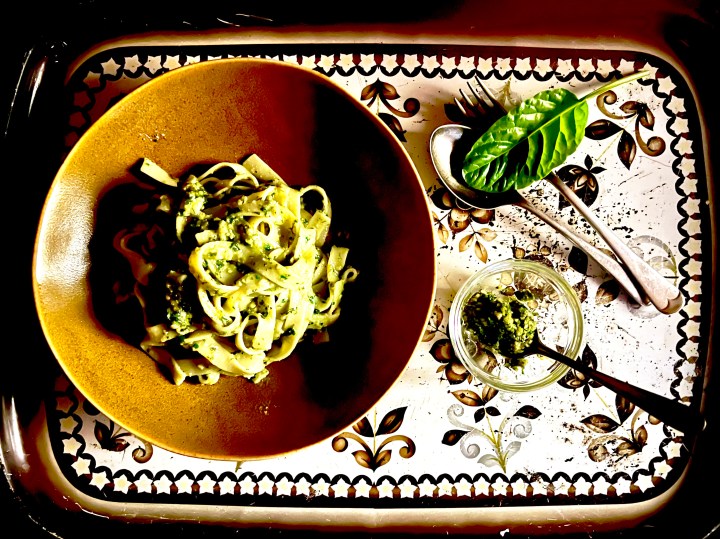HEY PESTO!
Throwback Thursday: Pesto pasta

Pesto is not, as many think, the Italian for ‘paste’. It means to pound, grind or crush, from the Genoese pesta(re), and refers to the method of making the pesto, as we today call the sauce known by that name. Paste, in fact, is impasto.
Traditionally, to make a pesto, the ingredients, most usually basil leaves, garlic, pine nuts and parmesan cheese, would be pounded in a mortar with a pestle, and the resulting paste used with cooked pasta. Today we often substitute a food processor of one kind or another for the mortar and pestle, and there’s nothing wrong with that unless you have purist leanings. Interestingly, the English word ‘pestle’ comes from the very same Latin root.
“Strictly speaking,” advises Wikipedia, “pesto is a generic term for anything made by pounding; that is why the word is used for several pestos in Italy. Nonetheless, pesto alla genovese (Genoese pesto) remains the most popular pesto in Italy and the rest of the world.”
The online encyclopaedia also cites a much older preparation, moretum, which the ancient Romans used to eat, “made by crushing garlic, salt, cheese, herbs, olive oil, and vinegar (and sometimes pine nuts) together”.
“The use of this paste in the Roman cuisine is mentioned in the Appendix Vergiliana, an ancient collection of poems in which the author details the preparation of moretum. During the Middle Ages, a popular sauce in the Genoan cuisine was agliata, which was a mash of garlic and walnuts, as garlic was a staple in the nutrition of Ligurians, especially for the seafarers.”
Basil is a much more recent addition to a pesto. It was only first documented in the mid-19th century when gastronomist Giovanni Battista Ratto published his book La Cuciniera Genovese in 1863: “Take a clove of garlic, basil or, when that is lacking, marjoram and parsley, grated Dutch and Parmigiano cheese and mix them with pine nuts and crush it all together in a mortar with a little butter until reduced to a paste. Then dissolve it with good and abundant oil. Lasagne and Trofie are dressed with this mash, made more liquid by adding a little hot water without salt.”
There’s a world of interesting information in that little description. From the inclusion of butter to Dutch cheese and two herbs we no longer associate with pesto in the traditional recipe, it is somewhat changed.
Wikipedia adds: “This recipe for pesto alla genovese was often revised in the following years (a noted revision by Emanuele Rossi occurred in 1865, only a couple of years after Ratto’s Cuciniera), and it shortly became a staple in the Ligurian culinary tradition, with each family often featuring its own pesto recipe (with slight differences to the traditional ingredients). This is the main reason why pesto recipes often differ from each other.”
There’s a pecking order of what to add and when. The pine nuts and garlic are first pounded by pestle in a mortar until creamy, then fresh basil leaves are added with coarse salt and the grinding continues. “Only then is a mix of Parmigiano-Reggiano and Pecorino added,” quoth the Oracle Wiki. “To help incorporate the cheese, a little extra-virgin olive oil is added.”
I would veer from that and advise that olive oil should be added until you are satisfied with the result; only a little may well be too little.
Pine nuts are very expensive so it has become common to replace them with another nut, such as cashews. That is what I used, but of course you can use pine nuts if your budget approves of them.
I have taken great liberties, having been given a bag of gloriously fresh garden herbs and other leaves, including rocket, fennel, basil and also having a bottle of basil-infused olive oil to hand. But use only basil if you like, or for that matter substitute rocket entirely, but when using rocket, use less of it than you would basil as rocket can be overwhelmingly bitter in a pesto. Best to balance it with more cheese.
(Makes sufficient for 4 portions of pasta)
Ingredients
Tagliatelle, as needed, cooked until al dente and drained
4 garlic cloves, de-husked
100 g raw cashews
A handful each of fresh basil, rocket and fennel fronds
Parmesan, as needed, grated
Basil olive oil or plain olive oil, as needed
Salt
Black pepper
Method
In a bowl or the bowl of a food processor, add the cashews and garlic and blend until creamy, while adding a little olive oil to aid the process. Add the leaves and continue processing. Add the cheese and continue pulsing the machine, adding olive oil until you like the resulting pesto. Season with salt and black pepper and pulse one or two times more.
Cook the pasta and drain. Immediately toss with the pesto and serve. DM/TGIFood
Follow Tony Jackman on Instagram @tony_jackman_cooks.
This dish is photographed in a bowl by Mervyn Gers Ceramics.



Comments - Please login in order to comment.